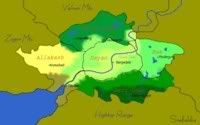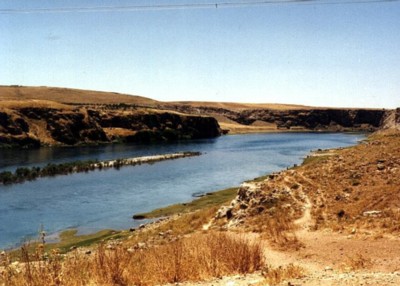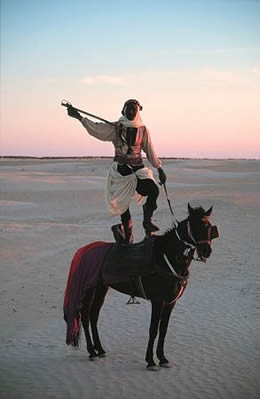Difference between revisions of "Snefaldia"
Kuroutesshin (Talk | contribs) |
m |
||
| Line 20: | Line 20: | ||
| population=1.519 billion | | population=1.519 billion | ||
| currency=[[me-wak]] | | currency=[[me-wak]] | ||
| − | }}'''The Centralized Mountain States Snefaldia''', informal '''Snefaldia''', is a | + | }}'''The Centralized Mountain States Snefaldia''', informal '''Snefaldia''', is a small country almost entirely surrounded by mountains amd bisected by the Saard river which runs through the mountains into a sea. Snefaldia refers to the snowy mountains that surround the nation, whose snowy peaks are almost always visible in the distance. The government is quasi-theocratic, and headed by an ecclesiastical assembly of religious officials known as the [[Tuhran Bel]], although the lower civil service administration is secular and non-discriminatory. |
The Centralized Mountains States belongs to the [[United Nations]], and considers itself a part of the region of the [[Antarctic Oasis]]. Snefaldia has an area of 181,040 sq km , 4,520 sq km of which is water. Arable land is 55.44% of the country, much of which is irrigated. The average life expectancy is 74 for men, 77 for women, with a low infanct mortality rate and a high literacy rate. The population is concentrated in the large regional cities and distributed throughout the countryside, with variations according to region, climate, and landscape. | The Centralized Mountains States belongs to the [[United Nations]], and considers itself a part of the region of the [[Antarctic Oasis]]. Snefaldia has an area of 181,040 sq km , 4,520 sq km of which is water. Arable land is 55.44% of the country, much of which is irrigated. The average life expectancy is 74 for men, 77 for women, with a low infanct mortality rate and a high literacy rate. The population is concentrated in the large regional cities and distributed throughout the countryside, with variations according to region, climate, and landscape. | ||
Revision as of 21:27, 30 September 2007

| |
| Flag of Snefaldia | |
| Motto: "Sanctus Verum, Sanctus Terra' | |
| National Anthem: Over the Drifts and Banks' | |
 " " | |
| Region | Antarctic Oasis |
|---|---|
| Capital | Sargedain |
| Largest city | Sargedain |
| Official Language(s) | Bagura, various regional tongues |
| Government | Theocracy/devolved confederalism |
| - governing body | Tuhran Bel |
| Establishment | |
| - Declaration of Supremacy | 1964 |
| Area | |
| - Total | 181,040 sq km |
| - % water | 5% |
| Population | 1.519 billion |
| Currency | me-wak |
| NS Sunset XML | |
The Centralized Mountains States belongs to the United Nations, and considers itself a part of the region of the Antarctic Oasis. Snefaldia has an area of 181,040 sq km , 4,520 sq km of which is water. Arable land is 55.44% of the country, much of which is irrigated. The average life expectancy is 74 for men, 77 for women, with a low infanct mortality rate and a high literacy rate. The population is concentrated in the large regional cities and distributed throughout the countryside, with variations according to region, climate, and landscape.
Risk of infectious disease is low on average, but higher in Neer Dal and Bae where waterborne diseases are common. HIV/AIDS is at the moment restricted to foreign travellers, due to stringent public health protocols and mandatory testing. Public health law mandates vaccination for infectious diseases, and healthcare is subsidized by the government.
The largest city in Snefaldia is Sargedain, which is also the capital.
Contents
Geography
Snefaldia is surrounded on all sides by high mountain ranges, with the Seril Mountains in the east, the Zogar Range to the west, the Hightops in the south, and the Velnar Mountains to the north. The central country is dotted with lakes and valleys, and the Saard river bisects the country, running from the northeast Velnars down through the southeast Serils before empyting into the Bay of Fuschal and the Memdar delta.
The centre of the country is called the Dayan Plain, and is very fertile, expansive, and covered in rolling hills. The Dayan flood plain forms the heart of Snefaldia. To the north is Sring Issa, defined by old-growth deciduous forests, low valley, and small, numerous lakes. South of the Saard and Dayan is Neer Dal, home to marshes, subtropical forests, and hundreds of small rivers.To the east, in the foothills of the Serils, is Bae, a region defined by deep gorges and hot, windy steppes. The western region of Allasha (archaic Allakash) is largely rolling hills and valleys, considered excellent farmland.
The mouth of the Saard river forms a fertile, shallow delta called the Memdar. Flanked by mountains and sheer rock faces, the area surround the mouth is nearly uninhabitable. However, due to the regular flooding of the Saard the soil is very rich, and in history city-states took advantage of this. This area, which is a high plateau that is cut through by the Saard, rise up from the Dayan plain and continues on until the sea, with a smaller depression where Taxilha sits. This area is collectively referred to as the Shahd, and forms the Shahd Autonomous Territory.
Snefaldia has five main regions and one seperate territory:
- Dayan
- Sring Issa
- Bae
- Allasha
- Neer Dal
- Shahd Autonomous Territory
Climate & Disposition
Snefaldia has a mixture of subtropical, temperate, and Alpine. The mountains are high and rocky, though lower in altitude are very hillish and flat before descending into the central plain. This change is elevation is reflected in the varied local climates. Many peope live in the traditional Snefaldian village.
The major cities and population centers of Snefaldia are often hundreds to thousands of years old, and were built before the advent of any central government. Due to the various regional histories and governments, there is a complex system of municipal organization that must be adhered to. According to the Uniform Laws on Civil Organization promulgated in 1965, the divisions between cities are thus:
- All cities constructed after 1965 must be registered and governed according to the Uniform Laws
- All cities/villages/towns built after 1895 but before 1965 must be registered according to the Uniform Laws
- All cities built after 1701 but before 1895 during the Segovan period are registered as "Chartered Settlements," and not subject to the Uniform Law
- All cities built after 1575 but before 1701 during the High Aatem period are registered as "Grant Cities" and not subject to the Uniform Law
- All cities built after 1035 but before 1575 during the Dayaniram and subsequent Low Aatem period are registered as "Free Cities" and subject to the Free City Codes of 1725.
- All inhabited cities built prior to 1035 are registered as "Foundation Cities" and allowed home rule with few exceptions. These cities include:
The second largest city is Taxilha, also the largest seaport. Sitting at the mouth of the Saard and the entrance to the sea, Taxilha handles all the sea trade that comes into the country. Conversely, Pholimjung in Bae is the largest source of finished goods for export, and has the highest percentage of skilled workers after Sargedain.
Korsahad, the capital of the Allashan region, can claim to be the largest provincial administration center outisde of Sargedain in Dayan, though it competes only with Mahavisjaya in the Neer Dal for production of raw materials- in Allasha the top being stone and minerals, and in Neer Dal being lumber and diamonds.
Demographics
- Main article(s): Society and Ethnicity in Snefaldia
Snefaldia society is a mixed one, with several distinct ethnic groups competing over land and resources. Largely divided along regional lines, the Dayan, Sringal, Bae, Neeri, and Allashi ethnic groups comprise Snefaldia societies, and make up the nation's national character.
Snefaldia has long been isolated from other nations, despite having a perfect seaport situated in the Memdar delta, but has never been a great seafaring or trading nation. Most foreign influence arrived through the mountain passes, and each region recieved a great deal of cultural influence from the peoples that made the trek over their respective mountain ranges.
Modern life revolves around community involvement, religious faith, industriousness, and the pursuity of aesthetics.
Timekeeping
Snefaldia uses the Gregorian calendar for dates in all public dispatches, but officially maintains the traditional lunar calendar, very similar to the Babylonian calendar. Snefaldia uses the 24-hour clock.
Holidays are almost completely indigenous, with very few foreign religious holidays coming into play; the notable exception being the Easter and Christmas celebrations of the Snefaldian Catholic Church.
- Holidays:
- New Year - January 1
- Nag Bed (Neer Dal)- February 1
- Commemoration of Aatem Nal - March 1
- Festival of the Vernal Equinox
- Feast of the Flooding - ~April 2
- Penang Nang Xie (Bae)- April 12
- Feast of Ta'us- May 22
- Festival of the Summer Solstice - June 21
- Storm Day (Allasha)- July 26
- Festival of the Motions- First week of August
- Festival of the Autumnal Equinox - September 23
- Sangi-nergal (Spirit Days)- October 29, 30, 31
- Autmnal Harvest/Autumn Flood - November 16
- Ibal - December 19
- Pilgrimage Day - December 30
Government
- Main article(s): Laws and Government of Snefaldia
The Centralised Mountain States are a mixture of theocratic instutions and secular government. Power is largely concentrated in the religious synod, the Tuhran Bel. The modern state, beginning in 1895, was a republic, which collapsed in 1963. The religious forces of Aatem Nal took control of the country's government after more than 60 years of republican government, but have not resumed the historical control that the Tuhran Bel formerly excercised.
There is a considerable amount of devolution in Snefaldia, with municipalities and regional governments being allowed a wide latitude in terms of policy. The Tuhran Bel is the final authority for all matters judicial, legislative, and executive, and is made up of 300 high-grade religious figures from the nation's three native faiths.
Though the official name of the country is the "Centralized Mountain States," the degree of centralization is often a topic of debate. Regional governments retain a significant amount of sovereignty, but almost alwys defer to the national government. Since Aatem Nal, the main religious force in the Tuhran Bel, maintains almost all of the educational centers, libraries, and government buildings, the degree of "national" control is a grey area.
Politics
- Main article(s): Politics of Snefaldia
The Tuhran Bel is not an elected body, but is appointed by a rotating Holy Council of 50 religious officials, who serve from within the Bel. The system is circular- the Council is chosen from the Bel by the senior members (those who have served more than ten years) and the Council in turn remove and appoint members to terms, in theory five years but in practice members serve at the pleasure of the Council. The system allows the Councillors and regular members (Bel Shahry) to check and balance each other.
Within the Bel, matters discussed are largely ecclesiastical and religious in nature, with secular and administrative duties only being taken up in important cases. The Bel oversees the secular government apparatuses, which largely run themselves.The Bel also functions as a body of arbitration for the religion of Aatem Nal, though it is not the temporal or ecclesiastical head of the faith. To be a member of the Bel, one must currently be either a ranking member of Aatem Nal, a Dragha, or a practitioner of Endiri. In recent years, progressive members have pushed for other religious figures to be allowed membership, such as priest from the Snefaldian Catholic Church and Islamic organizations.
Foreign Policy
Foreign policy in Snefaldia is largely conducted along economic lines, with the government actively seeking favorable trade and investment partners.
Snefaldia is a member of the United Nations, and has created a diplomatic corps for the express purpose of opening relations with the wider world.
Religion
- Main article(s): Religion in Snefaldia
Most major foreign religions are present in Snefaldia, but the majority of people adhere to one of the "Three Native Faiths", the native religion in Snefaldia. The "Three Native Faiths" are Endiri, Draghdatha, and Aatem Nal. Foreign faiths make up 5% of the national total, with Snefaldian Catholicism being the largest at 2%, Sunni Islam at 1%, and other faiths making up the remaining 2%.
Commerce, Media, and Life
- Main article(s): Commerce and Business in Snefaldia
Snefaldia is slowly developing foreign trade, and the main entry and exit for goods in the country is the large seaport of Taxilha at the mouth of the Saard river.
The principle exports of the country are agricultural products- both for consumption, industrial use, and private development. Mining in the mountainous areas yields copper, manganese, iron, coal, and gemstones. Neer Dal and Sring Issa have large foresting industries, who comply by government mandate with United Nations mandates as a form of due diligent Free Trade.
Bae, Neer Dal, and Sring Issa have high numbers of skilled craftsmen who produce high-end finished goods for foreign and upper-class consumption, but with the slow modernization in these regions, many are finding jobs in factories and textile mills.
Snefaldias' one major industrial production is in the area of zeppelin airships, which are used to traverse the high mountains and manage the wide agricultural plains. The Lindai Airship Company competes with the Telepe Zeppelin Corporation in this regard. The Snefaldia International Airport, located in Sargedain, is the only airport in the country that allows airplanes. All international flights enter and depart from Sargedain, and all connecting flights across the country must be made by airship.
Though the bay of Fuschal is very conducive to fishing, the fishing industry has not grown to fill the need. Instead, the Taxilhan mainstay is shipping- both in and out of the country. Finished products come down the Saard or by air, and are loaded onto ships in Taxilha.
The Ministry of Telecommunications manages television and radio broadcasts, though very loosely. Currently, Snefaldian TV carries two foreign channels: Ariddia's PINA and Cookesland's CBC.
History
- Main article(s): History of Snefaldia
Snefaldia was first populated by late Paleolithic humans, but the first records of human settlement come from the later Neolithic in the form of bone and rock tools. The first recognizable civilization was the southern Neer Dal culture, a forest-dwelling people that carved pictures in wood.
Written history begins in 500 BCE during the Terangal period, when inhabitants of Allasha, at that time lush and fertile, built the stone palaces at Terangal and Sumdarian. Radical climate changes and a shift in the Saard's course dried out the Allashan plain, and the centers of civilization at Terangal, Serangadai, and Walad were abandoned. Unfortunately, their language has remained indecipherable.
Armed Forces
- Main article(s): Military of Snefaldia
Snefaldia has a national military which is divided into three parts: Army, Airforce, and Navy. In addition, the regional governments are allowed under the Basic Law to levy their own Militia for defense. These militia are not subjected to the same restrictions as the national military, but may be called into active service in the case of a powerful war.
Of the three national branches, the Navy is the smallest, followed by the airforce, and then the Army. Being that Snefaldia has little to no connexion with the sea, the need for offensive naval power is low. The Navy is largely defensive, protecting the smaller islands in the Bay of Fuschal and Taxilha on the mouth of the Saard.
The Airforce is the second branch, and is largely for defensive purposes as well. Airships make up a large part of the defensive force, but modern jetfighters and stealth aircraft provide offensive capabilities. Given that the only major entrances into Snefaldia are by sea or by air (the mountains providing an excellent natural defense) it is important for the nation to have a good long-range defensive force to protect the skies over Snefaldia.
The Army is the largest and most important of the forces, though its importance in recent years has decreased with the unificaton of the country. The paradigm has changed from a largely offensive force controlled by various regional powers to a unified defensive force.
| Nations of Antarctic Oasis |
|---|
| Omigodtheykilledkenny | Lois-Must-Die | The Palentine | Palentine UN Office | Gruenberg | Kivisto | Karmicaria | Cluichstan* | Automobilistan | Cobdenia | LaivNFang | Akimonad | WhaleCo Global LLC | VISA Corp | Complete Malevolence | Snefaldia | Surly the Repealinator | Cookesland |







